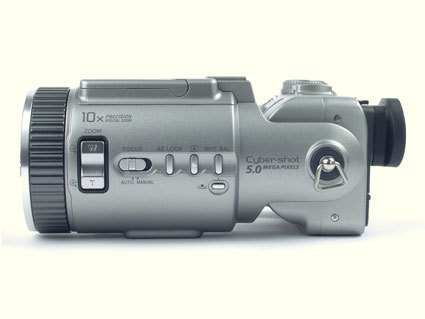Four 5-Megapixel Cameras In Review
In Use
This slow autofocus problem is quite bad and substantially reduces the camera's advantages, in spite of its undeniable optical advantages. Moving subjects, fleeting expressions and so forth are hard to capture. And it's also a shame that Sony uses such warm colors for its photos. They are not the only company to do so (Epson is another). They claim that the public, especially in America, prefer these bright tones. It's true that, when they are printed on some of the lower-priced printers, they come out better. But it would be a pity not to invest in a proper photo printer when you've shelled out $1000 for the camera. And in this case, it's better to touch up the photos and make their colors closer to reality.
Another complaint: the manual focus is deceptive. Don't put full trust in the monitor and sharpness of the subject when shooting. Find out the exact focus distance, otherwise, although the image appears sharp, the result will be blurred. Lastly, the electrical zoom control is not good enough, being too imprecise, too fast or too slow, depending on the situation. A ring is really missing here.
The DSC-F707 compensates with the quality of its photos. Compared to the E-20, Coolpix 5000 and Dimage 7, they are often the best defined, both in sharpness and in detail. This seems to prove the excellence of the sensor-plus-lens combination, as illustrated by our outdoor tests.
Target Market
It's hard to believe that this camera will appeal to a wider public than wealthy amateurs or professionals doing outside research. On paper, its features are appealing and seem designed for both amateurs and professionals. You do have automatic or manual white balance choices, but they are too restricted (only 4 available). It's the same for the zoom - the lens is fine, with a long focal range, but its controls make it hard to use. On the superficial side, you can fall for its looks or its acceptable movie, sound and night modes. Our tests showed how fast it is to boot and record photos in memory, and its excellent focusing. The image in the viewfinder and on screen is exactly the one recorded, which cannot be said for the Coolpix 5000 or the E-20. Another good point is its battery life, far longer than the other cameras tested. Lastly, it is easy to use.
The tests showed that the colors captured are too bright, the built-in flash vignettes the images and makes them lose detail, and the autofocus is a bit slow. On the other hand, the DSC-F707 has the best lens by far, as shown in the greater detail of its photos compared to those of its rivals.
Get Tom's Hardware's best news and in-depth reviews, straight to your inbox.

